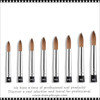Frequently bought together:
Description
FLEXBRUSH KOLINSKY Black Wood Handle Acrylic Brush
ABOUT THIS ITEM
- Hair/Bristle: KOLINSKY/RED SABLE is best use for acrylic systems
- Handle Color: Wood paint black lacquer with Acetone and Liquid Monomer proof.
- Brush hairs are obtained from members of the weasel family with "red" hair. The Quality and characteristics of weasel hairs vary greatly.
- The finest soft brush hairs are obtained from the Kolinsky, a Long-tailed weaseled animal found in cold regions of Russia and China. Each Kolinsky hair has a fine point, and its overall structure ensures that the hairs cling closely together when wet. More specifically, the guard hairs from the tail of a male Kolinsky make the best brushes. These hairs are unsurpassed for spring and strength, they are the standard by which all other soft hairs (synthetic or natural) are judged.
- Red sable brushes of lesser quality may be made of hair taken from other body areas of the male Kolinsky, female Kolinskies (shorter hair) and other European or Chinese weasels.
- Red Sable hair has a natural thickness at the belly which provides superior spring and snap. This thickness can be placed just inside or outside the ferrule and the performance characteristics of the brush will vary accordingly. In order to do this, long hairs must be used and about half of their length will be contained inside the ferrule.
- Because of their strength, spring, and absorbency, high-quality Kolinsky brushes are considered to be the best for Acrylic, which requires that a brush be able to hold the liquid long and retain a fine point when wet.
- Important to this ability to hold liquid are the absorbent properties of a brush. This is its ability to act as a reservoir and release liquid in a controlled manner according to a nail tech. Natural hair has a center structure called the medulla which is covered by a thick sheath known as the
- cortex and layered by a shell of scales. These scales and hollows within the center structure hold and trap the liquid, releasing it as pressure is applied to the brush.
Brush Shapes and Their Uses
ROUND

-
Use on point, or apply pressure to make thick-to-thin strokes.
- This is the less common use by nail tech.
- Strokes with soft edges.
- A round brush have a largest belly hold a large amount of liquid monomer offering the versatility of multiple strokes. Pick up acrylic powder by the point and form a round ball.
OVAL

-
- This is the most common and versatile style of brush.
- Strokes with soft edges. Blending. A natural flower petal shape.
- The oval brush is same structure with round brush but manufacture press to flat ferrule to have a shape between round and flat.
- A Oval brush have a large belly hold a large amount of liquid monomer offering the versatility of multiple strokes. Pick up Acrylic powder the from one side of brush.
Brush Care & Tips.
- Proper use, together with correct care and cleaning will ensure your brushes have longer life.
- I hope the following tips will help.
- Storage is important - always keep aired and whenever possible, in the upright position. Natural hair needs to breathe in order to prevent mould growth. Keep your brushes out of direct sunlight.
- Try to keep handles dry, to prevent them from loosening and cracking. When you dip the head into liquid monomer or brush cleaner, try to keep the liquid level below the crimping and only wet the ferrule.
- Moulting or shedding hairs from a new brush is a normal process. Once the brush is broken in and following a few application sessions the moulting will stop. Always thoroughly rinse a new brush with brush cleaner or liquid monomer before first use.
- Always clean a good quality brush thoroughly after each processing session with brush cleaner or liquid monomer DO NOT USE ACETONE because Acetone will remove the shine from bristle make acrylic tacky and buildup residue. Remove as much moisture as possible with paper towel and reshape before storing.
COLOR ACCURACY
- We have made every effort to make the colors on screen as accurate as possible.
- Unfortunately, we cannot guarantee an exact color match of the on screen color to the colors of the actual products and the color appearing on screen should not be relied on as being such.
- Colors on screen may vary depending on your screen settings and resolution.











